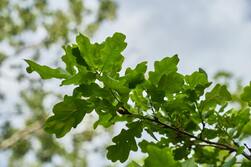CONSERVATION CORNER
A weekly blog for all things conservation
 By: Tori Bristol, Dirt, Gravel & Low Volume Roads Specialist The time of year has come during which, many of us might hear a sharp thwack! on the roof, followed by an increasingly quieter bump bump bump bump. Yes, the annual attack of the oak trees has commenced, signaled by the sound of acorns storming the roof. We all know that from tiny acorns mighty oak trees grow, but we should also add that those tiny acorns will also grow whitetail deer, squirrels, chipmunks, turkeys, crows, rabbits, opossums, blue jays, quail, raccoons, wood ducks, bear—more than 100 wildlife species eat acorns. Like a good fine wine, acorns come in two different types: red and white, depending on the type of oak they come from. White oaks, which grow leaves with rounded edges and drop acorns every year, include species such as the chinkapin, swamp chestnut oak, live oak and post oak. The red oaks, have leaves with pointed edges and drop acorns every other year, include scrub, willow, and black oak.
Although acorns from the red group of oaks tend to be higher in fat, protein, calories and fiber than acorns from white oaks, the bitter quality (think of how you pucker up when you bite into unripe fruit) of red acorns makes them less appetizing to wildlife, both due to taste and digestibility. Ergo, animals vacuum up acorns from the white oak more than they do the reds. For the whitetail hunters out there, acorns can compose more than 75 percent of a white-tailed deer’s diet in late fall and early winter and when the acorn crop is especially good, deer may produce more twin fawns, thanks to improved nutrition. Don’t write off the red oak! As mentioned before due to more tannins produced in the red oak, animals prefer the white oaks over the red, and many hunters will completely write off red oaks and only focus on white oaks as a food source to hunt. This is a major mistake, red oaks can be a dynamite food source late in the season. By utilizing the natural food source of oak trees during early archery season or late season in January, more opportunities will present themselves during your hunting season. However, oak trees can be far and few between here in Pennsylvania due to the value they once held for timber when the European settlers first arrived. Many of us know the quote “The best time to plant an oak tree was twenty years ago. The second best time is today.” Due to the many animals that consume acorns over winter, oak trees have a difficult time regenerating in the forest. There are many great reasons to grow your own oak seedlings…for wildlife, forest regeneration and natural beauty are a few of my favorite reasons. One of the easiest ways to grow your own seedlings is to collect acorns and plant them. Check out next week’s Conservation Corner for tips and tricks on harvesting and planting your own acorns! The Bradford County Conservation District is committed to helping people manage resources wisely. You can visit the Bradford County Conservation District at 200 Lake Rd in Wysox across from the Wysox Fire Hall. Contact us at (570) 485-3144 or visit our web page at www.bccdpa.com.
0 Comments
Leave a Reply. |
AuthorsVarious staff at the Bradford County Conservation District Archives
July 2024
Categories
All
|
|
Bradford County Conservation District
Stoll Natural Resource Center 200 Lake Road, Suite E | Towanda PA 18848 Phone: (570)-485-3144 |
